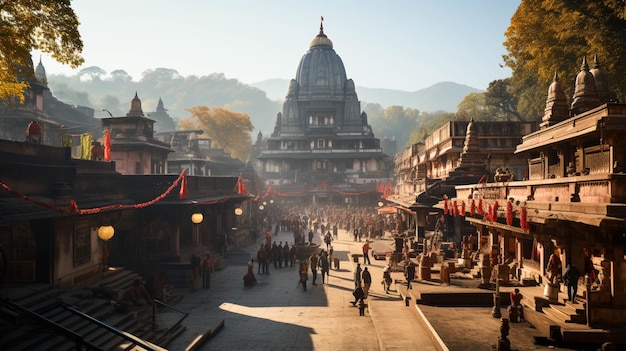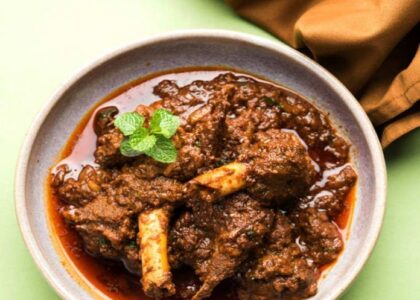Nestled amid the tranquil scenery of Assam’s landscapes, the Kamakhya Temple in Guwahati serves as a profound symbol of India’s abundant spiritual legacy and cultural tapestry. This time-honored temple, situated atop the Nilachal Hill, not only beckons pilgrims and devoted worshippers from across the nation but also piques the curiosity of inquisitive travelers eager to unearth its secrets. In this blog, we will discuss about the Kamakhya Temple’s lesser-known facts that make it so enthralling and magical.
1. Ancient Origins:
The Kamakhya Temple is one of the oldest and most revered temples in India, with origins dating back over 2,500 years. It is believed to have been rebuilt multiple times over the centuries, with its present form constructed in the 16th century.
2. No Idol Worship:
Unlike most Hindu temples, Kamakhya does not have a traditional idol of a deity. Instead, it features a naturally occurring rock formation that resembles a yoni (female reproductive organ). This symbolizes the goddess Kamakhya, and the temple’s primary focus is on the sacred yoni.
3. Unique Menstruation Ritual:
Kamakhya Temple is known for the Ambubachi Mela, a unique annual festival that celebrates the goddess’s menstruation. During this time, the temple is closed for three days, as it is believed that the goddess’s powers are at their peak. On the fourth day, the temple reopens, and devotees visit to receive her blessings.
4. Tantric Practices:
Kamakhya Temple is closely associated with Tantric rituals and practices. It is considered one of the most important Tantric shrines in India. Tantrism, a branch of Hinduism, focuses on harnessing divine energy for spiritual growth.
Location:
The temple is situated on the Nilachal Hill in Guwahati, Assam, overlooking the Brahmaputra River. Its scenic location provides breathtaking panoramic views of the surrounding landscape.
Seven Shakti Peethas:
Kamakhya Temple is one of the 51 Shakti Peethas in Hindu mythology, where body parts of the goddess Sati (an incarnation of Shakti) are believed to have fallen. In Kamakhya, the yoni (reproductive organ) of Sati is said to have fallen.
Blend of Beliefs:
The temple is a place where both Vedic and Tantric forms of worship coexist harmoniously. This unique blend of beliefs and practices attracts devotees from all over the world.
Kalika Purana:
The Kalika Purana, an ancient scripture, describes Kamakhya as the “Supreme Goddess of Desire,” emphasizing her role as the granter of wishes and desires to her devotees.
Animal Sacrifice:
In the past, the temple was associated with the practice of animal sacrifice, particularly goats and pigeons. However, these practices have diminished over time, and today, symbolic offerings are made instead.
Preservation of Biodiversity:
The Kamakhya Temple complex is nestled within a lush green forest area known as the Kamakhya Hills. Efforts have been made to preserve the biodiversity of this region, which is home to various flora and fauna.
The Kamakhya Temple in Guwahati transcends its role as a mere religious site; it serves as a vibrant embodiment of India’s spiritual and cultural tapestry. Its storied past, distinctive rituals, and profound spiritual importance render it a captivating destination for individuals intrigued by Hinduism, spirituality, and time-honored customs. Whether your purpose is to seek blessings, marvel at its architectural splendor, or delve into its mystique, a pilgrimage to the Kamakhya Temple guarantees an indelible encounter steeped in both history and spirituality.
-
Rustic, Real, and Regional: Kullu Trout for Every Food Lover
Spread the loveIf you are craving a wholesome, flavorful fish dish that’s both light and satisfying, Kullu Trout is the answer. Hailing from the scenic valleys of Himachal Pradesh, this trout preparation is a tribute to simplicity — where the freshness of the fish is allowed to shine through, enhanced only by subtle spices and…
-
Flavorful Himachali Chha Gosht Recipe You Can Cook Easily at Home
Spread the loveIf you are looking to bring bold, regional Indian flavors to your kitchen, Chha Gosht is a must-try. This Himachali lamb curry is a rustic, aromatic dish made with marinated lamb slow-cooked in a yogurt-based gravy thickened with roasted gram flour (besan). Rich in spices like cardamom, coriander, bay leaf, and ginger, it…
-
Flame-Kissed Perfection: Rajasthani Kalmi Kebab at Home
Spread the loveWhen it comes to Indian starters that leave a lasting impression, Kalmi Kebab stands tall with its smoky aroma, melt-in-your-mouth tenderness, and bold, royal flavors. Originating from the princely kitchens of Rajasthan, this grilled chicken dish has become a favorite across India, especially at festive dinners, barbecues, and celebratory gatherings. The best part?…
-
Authentic Rajasthani Dahi ke Kebab Recipe for Home Cooks
Spread the loveAmong the many gems of Rajasthani fare, one dish that stands out for its elegance and surprising simplicity is the Dahi ke Kebab — soft, creamy yogurt-based kebabs that melt in your mouth. Often served as an appetizer in royal thalis or festive meals, Dahi ke Kebab (Yogurt Kebabs) are a vegetarian’s delight.…
-
Bring Jodhpur to Your Kitchen with This Easy Kachori Recipe
Spread the loveWhen it comes to Indian street food, few snacks can rival the irresistible charm of Pyaaz Ki Kachori — a flaky, golden pastry stuffed with spicy onion filling that bursts with flavor in every bite. This beloved Rajasthani treat, which hails from the vibrant city of Jodhpur, has earned a place in the…
-
Bring Rajasthani Flavors to Your Kitchen with Homemade Thepla
Spread the loveIf you are looking for a wholesome, flavorful, and satisfying flatbread that’s as healthy as it is delicious, Methi Thepla should be at the top of your list. A beloved breakfast and snack in both Rajasthani and Gujarati households, Methi Thepla is a spiced flatbread made with fresh fenugreek leaves (methi) and a…









